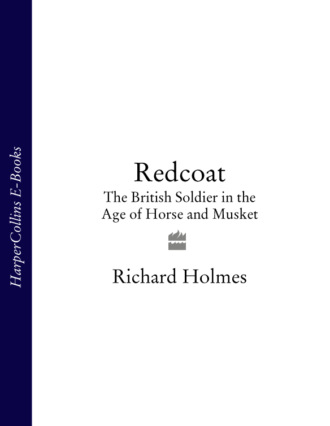
Полная версия
Redcoat: The British Soldier in the Age of Horse and Musket
His name is Ezekiel Hobden, Hobden to officers, NCOs and most private soldiers but Zeke to a favoured few. On his attestation form he signified his intention ‘to serve His Majesty until I be legally discharged’ with a bold cross, alongside which a Justice of the Peace and another witness (who has helpfully included Esquire as part of his signature to make the point) have appended their names. He used to be a plough-boy from the gentle downlands above Alresford in Hampshire, but a row with his master and an evening’s drinking saw him take the King’s shilling in Winchester. Now his old calling is like some half-remembered dream, although when he sees Portuguese peasants ploughing their red soil he still recalls the plodding team in front and the rich dark earth rolling from the coulter behind. Had he ever heard of Shakespeare he would agree that ‘things without remedy should be without regard’, but today it will be enough for him to be alive come sunset.
He stands 5ft 6ins tall – taller than many of his comrades – and now he himself is a beast of burden. Broad buff-leather cross belts meet on his chest, with an oval plate at their intersection; thinner buff straps run down from his shoulders and across his chest, and a brown leather strap lies across his right shoulder with the thick canvas belt of a haversack alongside it. We can see, even from the front, the edges of his black canvas pack, and the grey greatcoat strapped on top of it stands well above his shoulders. A black cartridge box hangs at his right hip, and bayonet-scabbard and round wooden water bottle at his left.
His hands have the same worn-leather hue and texture as his face, and their short finger-nails are black-edged. They bear a dozen new cuts and old scars, and his right thumb is thickened with a mighty callous. His left hand hangs loosely by his side, while his right – thumb and forefinger apart – rests lightly on the bright steel barrel of his upright musket. Its 39-inch barrel is tipped with a bayonet, sixteen inches of triangular steel, its point level with his shako-plate.
There is an animal tang about him which even that fine natural deodorant, the pervasive wood-smoke, cannot conceal. In part, it stems from the fact that he has worn the same jacket for six months and it smells powerfully of old sweat laced with the bad-egg stink of black powder, the muddy odour of the pipe-clay which whitens his belts, and the sharper nip of the brick-dust which, dampened by water, brings the metalwork of his musket and the brass of his accoutrements to a shine. It must be said, though, that not much polishing has gone on of late. He has only worn his heavy linen shirt for a week, and so may hope to get another week or more from it yet, but our nose tells us that it is already past its best, and is not much helped by the fact that, long tails tucked in between his legs, it doubles as underwear. Even when clean it was not entirely sweet: the soap used to wash it was made from mutton-fat, and the gentlest scent of roast lamb mingles with the other smells. He cleaned his teeth this morning, using the well-chewed end of a green twig as a brush, but these efforts cannot conceal the facts that there were onions in his supper and rum after it.
To left and right, in a line 250 yards long, stand similar figures. And similar is the word, for they are by no means uniform: there is infinite variety in the injury sustained by shakos and the nature and quality of the patches on clothes. One man has lost his shako altogether, and wears an incongruous round black hat. He does not look his best, and not simply because of this sartorial defect: we may confidently assume that the missing item will not redound to his advantage. The men stand shoulder to shoulder, elbows touching, in two ranks a pace apart, in ten distinct company groups. Each company has about fifty private soldiers and corporals, with three officers, two sergeants and a drummer or two. Some of these worthies stand alongside their companies, while others, the file-closers, lurk behind the second rank. There is some movement amongst the captains, who command the companies: three of them have left their stations on their companies’ right and are pacing about in front. One has had a word with the soldier in the round hat, and is stalking down the ranks intent on further mischief.
The officers carry slim, straight gilt-hilted swords and show their status by crimson silk sashes, knotted over their left hips, and their rank by fringed epaulettes. Some have pistols tucked into their sashes or slung in open-topped leather holsters. The sergeants have simpler swords and also wear sashes, but theirs bear a broad central stripe of the same hue as collar and cuffs. They carry half-pikes, whose broad blades tip nine-foot ash hafts.
There is clearly something different about the two companies on each flank. In both cases their sergeants carry muskets and their officers curved sabres. The soldiers wear lace-embellished wings on their shoulders and the officers a more elaborate version in gold braid. The right flank company sports white shako pom-poms, for these are the battalion’s grenadiers, and the white commemorates the smoke of the grenades their forefathers threw. They are noticeably bigger men than their comrades in the other companies, and have an unmistakable air to them. At the other end of the line the pom-poms are green: this is the light company, containing the battalion’s best shots. Although its soldiers may lack the swagger of the grenadiers, there are several keen-eyed countrymen amongst them, and we may just see – as, indeed, one of the file-closing sergeants already has – that a hare’s paw is protruding from one man’s haversack. There has already been murder this morning, and there will be more before nightfall.
Behind the file-closers stand the drummers, grouped behind their companies, yellow tunics faced with red and laced with much white worsted. In the centre rear are two mounted officers, a major, the battalion’s second-in command, on the right and the adjutant, the commander’s personal staff officer, on the left. Further back stand a dozen pioneers, equipped with shovel and axe. The ‘band of music’ stands to the rear, but today the musicians have laid aside their instruments and are ready to act as stretcher-bearers, although their stretchers are simply sewn blankets looped between two stout poles. The battalion’s surgeon and his assistant, in dour anticipation of business to come, have unpacked their instruments from their mule and have blankets and water to hand.
In the centre the battalion’s colours jut sharply above the line. Both are of embroidered silk. One, the king’s colour, is the Union flag, and the other, the regimental colour, is the now-familiar yellow with the national flag in the upper corner where it joins the staff. The regiment’s number, wreathed in laurel, is in the colour’s centre. The pike is tipped by a spear point, now ornamental, from which hangs a long double tassel. Although at present the colours rest with their butts on the ground, the two young officers who bear them have broad shoulder-belts, with a strategically situated metal-lined pouch to support them when they are carried.
And young is indeed the word. The ensign bearing the Regimental colour cannot be more than sixteen, and seems in the grip of some powerful emotion. He is as white as a sheet, and though he is standing stiff and straight he is swallowing more than a boy ought. His comrade with the king’s colour is altogether more cheery. He is a big lad, and has already outgrown his tunic: lanky wrists and grubby shirt-cuffs protrude from its sleeves, and it is tight across his chest. His beefy face wears an unconcerned grin, and he seems to have enjoyed a whispered joke with the non-commissioned officer to his rear. Behind each officer stands a pike-armed sergeant: the one behind the regimental colour has inched forward till he is nearly touching its ensign, and is whispering, between clenched teeth: ‘Steady sir, steady: waiting is the hardest part, and ‘twill all be well when the ball opens.’
The officer who we might suppose has something to do with opening the ball is the lieutenant colonel commanding the battalion. He is a surprisingly young man – no more than thirty – on a little chestnut mare, standing on the gentle crest about a hundred yards in front of his men. He looks intently into the valley on its far side and occasionally glances to his left where, 400 yards away, his brigade commander, responsible for another three battalions all tucked in behind the same slope, sits astride his horse with two other mounted officers.
Although Hobden and his five hundred comrades cannot see what is happening on the other side of the hill, they can certainly hear it For half an hour now the distant popping of musketry has swollen to an almost continuous roar, interspersed with the thump of cannon. There is a good deal of shouting, the occasional anguished yell, and, more particularly of late, the clear notes of a bugle. Some minutes ago a cannon ball skidded over the crest, its force almost spent, sending up a shower of gravel as it bounded its way to a halt away to the battalion’s left. Wounded men, in red, dark green and Portuguese grey homespun, have been drifting back over the ridge for some time. Some are going well, limping along with sticks or walking briskly with a bound-up arm, but there are already some chilling sights: one man comes past slowly, wordlessly clutching his belly, and another has lost part of his face to a vicious sword-cut. The noise intensifies, and separate drumbeats soon coalesce into a steady sound. One of the officers present, unversed in musical minutiae of flams and paradiddles, will later describe it as: ‘the rum dum, the rum dum, the rum dum dummadum dum dum.’ It becomes louder and louder. Old soldiers exchange knowing glances, and some risk a sergeant’s ire by muttering ‘look sharp, for here comes here comes old trousers,’ their nickname for the pas de charge, the call beaten by the drummers accompanying French infantry going forward at the quickstep. There are soldiers on the crest-line now, riflemen in dark green, moving in pairs, one kneeling to fire into the valley while his comrade scurries back. The British skirmishers, who have borne the brunt of the fighting so far, have been driven in.
The brigade commander doffs his cocked hat, and waves it unmistakably. The colonel turns his horse, walks it easily back to his battalion, and halts in front of the front rank. ‘Thirty-Seventh,’ he shouts, and officers and men respond by bracing up, swords and muskets tight in between body and right arm. ‘Battalion will shoulder…Arms!’ On the last word muskets are tossed across the body so that their brass butt-plates now rest in the left hand, and the ensigns raise their colours, dropping their staffs into the pouches on their colour-belts. ‘By the centre…March.’ And they step off, as one man, with the left foot, boots swinging low over the earth in 30-inch steps at 75 paces to the minute. The drums tap out the step as the line moves forward, men looking in to the centre to get their dressing from the colours, file closers chivvying here and there to ensure that the rear rank stays well closed up.
As the battalion crosses the crest it is greeted by a vision of hell. Clouds of thick smoke, the product of a battle between opposing skirmishers which the enemy seems to have won, cannot conceal the fact that the valley is full of blue-clad French troops, now coming on, up the slope, in thick columns. And they are coming on in the bravest style, their drummers hammering out the pas de charge, officers shouting encouragement, and men whooping ‘Vive L’Empereur‘. One little spark is actually marching backwards, his shako raised on his sword-point, yelling that the Emperor will reward those who fight bravely. The nearest French column is three full battalions strong, stacked company behind company on a two-company front, fifty yards wide and almost twice as deep. The voltigeurs – equivalent of the 37th’s light company – have been skirmishing ahead of the column and some now begin to peck away at the British line from close range: with the clatter of a tinker’s pack one front-rank redcoat drops his musket, briefly kneels over it and then falls flat. The French grenadiers are leading their regiment, just as their British equivalents would be if the roles were reversed. They are big, stern men with red ornaments to their shakos, a forest of facial hair and the glitter of military dandysim: gold earrings, and silver ornaments on their clubbed hair. At least one British soldier is frankly shocked: ‘Their hats, set round with feathers, their beards long and black, gave them a fierce look. Their stature was superior to ours; most of us were young. We looked like boys; they looked like savages.’1 The French are used to winning, and indeed think that they have all but won today. They have brushed aside some British riflemen and Portuguese caçadores, and there seems to be very few of the enemy to their front.
Raising his voice against the din, the colonel gives a long drawnout preparatory command of ‘Thirty-Seventh’ and follows it three paces later, with ‘Halt’. The drums cease on the instant, lending emphasis to the order, and the battalion stands steady, looking down, across open ground speckled with scrub oak and cork trees, at the head of the oncoming column only 300 yards away. The colonel rides round the right flank of his battalion, and takes station just behind the colours. It is not until the French have come another hundred yards, though now, very evidently, a little more slowly than before, as the moral effect of the line’s steadiness makes itself felt, that he shouts ‘Front rank: Make ready’. The drummers beat the short roll of the ‘preparative’; captains step back behind the second rank; the front rank’s muskets come up, still perpendicular, but now with the left hand to the walnut fore-end and the right just below the lock, with those callused thumbs resting on the flint-gripping jaws of the musket’s cock. The soldiers of the second rank step half a pace forward and to their right, in a movement called ‘locking on,’ so that, when their turn comes to fire, they will have space to do so.
The column is now less than a hundred yards away. Many features of its members can be clearly seen now. Its colonel has the cross of the Legion of Honour, and is having trouble with his horse, but keeps it going straight with short reins and sharp kicks. His officers and NCOs are desperately urging their men to close up: ‘Serrez les rangs, serrez!’ For they know what is coming: it is too late – and too close to that line – to meet fire with fire, and so if they are to succeed the sheer momentum of their mass must not be lost. They are only fifty yards away, close enough now to see now that their enemy’s commander has a thin face and a sharp nose, when the command ‘Present…Fire’ rings out The British front rank fires a volley of shattering precision. Its muskets were carefully loaded in safety behind the crest: their flints and priming alike are fresh. Without delay the colonel orders: ‘Front rank: load and prime. Rear rank: Make ready…Present…Fire.’
In just over thirty seconds each rank has fired two volleys, a total of two thousand musket balls at a range so close that even the unreliable Brown Bess musket is hitting a mass target about once in every ten shots. The head of the column falls like corn before the reaper. Its colonel, an attractive target – not least to the man in the round hat, who has his own views on officers, British or foreign – has half a dozen fatal wounds within seconds. As men in the front ranks fall, their comrades further back are exposed to the winnowing blast of musketry. Men trip over the dead and dying. Some, deaf to the shouts of their own officers and NCOs, who know that if they are to win it will be by shock, not fire, stop to fire back, and others strive frantically to position themselves behind those in front.
A few brave souls get as far as the British line. One thrusts hard, musket flung out to the full stretch of his right arm, with all his weight behind it. His bayonet grazes the side of a front-rank man and jams deep in his pack. Before the Frenchman can recover it, the rear-rank man shoots him in the chest from such close range that his coat smoulders. Although the volleys are still quite regular and accurate, there are signs that this will not last; some men fire at threatening close-range targets as they present themselves, and others fire on the word of command; but, almost dazed by the noise and concussion, they seem to have little regard for where their shots are going.
The colonel’s voice and another drum-roll interrupt the firing. ‘Now, Thirty-Seventh, I am about to give the word to charge. Three cheers for the king.’ There are three harsh, barking cheers: on the word ‘Charge…bayonets’ the muskets come down to hip level, held across the body. Then the men are off down the slope, bounding over the dead and dying. There is a brief flurry of bayonet fighting where line meets the wreckage of the column, but most Frenchmen do not stay to meet the steel. A good number, huddling in a nervous clump, surrender. Most surrenders are accepted with good nature, but one man deliberately bayonets a Frenchman who offers no resistance but, stunned by the horror around him, is slow to drop his musket. The rest are away, running, free of musket and pack, and so much faster than their pursuers.
The colours move quickly down the slope, the pale ensign now wild with excitement, his sergeant, pike thrust out in front of them, again urging steadiness, but this time with a different cause. The action has had its tragedies, even for the victors. The king’s colour is now borne by a sergeant and back up the slope, in a thin tide-line of redcoated bodies, its fat-faced ensign lies flat on his back with a blue hole in his forehead and the back blown off his head. There will be a Gloucestershire vicarage for which Christmas will not be the same this year. The surgeon and his mate are busy bandaging and probing. Of the eighteen British wounded five, with bullet-wounds to the abdomen, are probably beyond hope. Three must have smashed limbs amputated, and are more likely to die than survive. The remaining ten have a variety of injuries – one unlucky fellow has had his jaw broken by the French colonel’s horse, kicking out in its death-throes as he rifled its saddlebags – but will live to fight another day.
At the foot of the slope the line rallies on the colours and the companies reform. Private Hobden, face and uniform smutty with powder-smoke, and mouth black with gunpowder from biting open his cartridges, pockets a gold watch and crucifix eased from a Frenchman’s pocket. He has also found a buckwheat pancake in someone’s discarded shako, and chews it quietly as he picks up his dressing, touching elbows to left and right, and squinting up to see the colours catching the first rays of sun to break through the smoke.2
Seven years later, in April 1815, a few weeks before the battle of Waterloo, the Duke of Wellington was walking in a Brussels park with the radical diarist Thomas Creevey. Creevey asked the Duke how he thought the coming battle would go.
‘By God! I think Blücher and myself can do the thing.’
‘Do you calculate upon any desertion in Bonaparte’s army?’
‘Not a man, from the colonel to the private…We may pick up a marshal or two, perhaps, but not worth a damn.’
‘Do you reckon upon any support from the French king’s troops at Alost?’
‘Oh! Don’t mention such fellowsl No: I think Blücher and I can do the business.’
Just then a lone British infantryman appeared, walking about the park and gawping at the statues: Hobden, perhaps even Sergeant Hobden, although rather less scruffy then when we last met him.
‘There,’ said the Duke, pointing at the red-coated figure. ‘It all depends on that article there whether we do the business or not. Give me enough of it, and I am sure.’3
This book is about ‘that article there’, the redcoated soldier of the British regular army, like Ezekiel Hobden of the 37th Regiment. And it is about Hobden’s father and son as well, for my period opens with the start of the Seven Years’ War in 1756 and ends with the Indian Mutiny just over a century later. During it the British infantry-man wore a red coat in battle and carried the muzzle-loading flintlock musket known (though the first printed reference to the name is not found till 1785) as Brown Bess. This weapon had several variants. Most encountered today were mass-produced during the Napoleonic Wars, and are the India pattern, introduced into the British service in 1794 by large-scale cession from the East India Company when arms manufacturers, domestic and foreign, were unable to keep pace with the demands of war against Revolutionary France.4 The first Brown Besses appeared in the late 1730s, and the last were carried – although they were by then long obsolete – by some combatants in the Crimean War of 1854–56 and even the Indian Mutiny of 1857–58.
SCARLET AND BLUE
THE FRAMEWORK INTO WHICH Hobden’s army fitted was clear by 1760. It was to change little until the eve of the First World War, and its influence has persisted well into our own times. The army’s two main functions were twisted closely together like the strands of a rope. It had a continental role, which it exercised alongside allies and against opponents with both of whom, but for the colour of their coats, it often had much in common. With the continental commitment came a regard for formalism in drill and dress, and an emphasis on the scientific aspects of war like fortification, siegecraft and artillery. In its continental role the British army fought as part of a coalition: two of its greatest generals, Marlborough and Wellington, commanded more non-British than British troops in their biggest battles. But although the British sometimes tugged with a greater weight on the allied chain of command than their numerical contribution seemed to justify, there was no escaping the fact that theirs was a tiny army by the standards of continental war. In the late eighteenth century ‘His Sardinian Majesty could boast an army equal in size to that of King George I.’5
Into this was wound a colonial thread, in which practicality ranked higher than precedent, dress and discipline tended to be looser, and there were more raids and ambushes than pitched battles. Even when there was no colonial campaigning, the outposts of empire needed garrisoning. In the early eighteenth century several regiments served abroad for twenty-five unbroken years, and the unlucky 38th Regiment spent 1716 to 1765 on the Leeward Islands in the Caribbean. A system of unit rotation was instituted in 1749, and although the demands of war interfered with its measured operation, it was at least a start. Yet it was not to prevent the 67th Regiment from spending 1805–26 in India and then setting off in 1832 for Gibraltar, the West Indies and Canada, where it remained till 1841. Some foreign postings were more lethal than any battle: the 38th Regiment lost 1,068 men, most of them to disease, in seven years in the West Indies, and during the 1740s even regiments in the relatively benign Gibraltar lost seventeen per cent of their strength each year.
The continental and colonial functions were never wholly distinct, any more than they were in the 1960s, when a unit serving in the British Army of the Rhine might find itself sent half a world away to fight an insurgent enemy in paddy-field or rubber plantation. Nor were the techniques and organisations of European and colonial campaigning always separate, as two brief examples show. First, the main impetus for raising light troops was colonial, but such soldiers had a useful part to play in Europe. Second, the export of European military techniques meant that both India and North America witnessed sieges and battles as formal as anything the British army encountered on the continent. Lastly, domestic tasks wove a third skein into the rope. The army had a crucial role in the preservation of public order, all the more so in the absence of an effective police force. It was also repeatedly involved in ‘coast duty’, assisting Revenue officers in their war on smuggling.
Britain’s military policy was determined as much by the physical location of the British Isles as by the wishes of their rulers. As Admiral Earl St Vincent told the House of Lords: ‘I do not say the French cannot come: I only say they cannot come by sea.’ The dual need to defend Britain from invasion and protect her overseas trade had encouraged the development of a navy which, by 1689, was the equal of the Dutch and the French, and during the eighteenth century the Royal Navy confirmed a predominance it was not to lose till the twentieth. It was able to do so primarily because Britain, with no land frontier with a potentially hostile foreign power, was able to devote the lion’s share of her defence expenditure to the fleet. There were no fortress-lines to build, improve and maintain, and no need to sustain a large army in time of peace. The strategist Basil Liddell Hart was later to identify ‘a distinctively British practice of war, based on experience and proved by three centuries of success.’6 Naval dominance ‘had two arms, one financial, which embraced the subsidising and military provisioning of allies; the other military, which embraced sea-borne expeditions against the enemy’s vulnerable extremities.’7 Scholars have rightly pointed out that this is strategic theory rather than military history, and that Britain has not always had continental allies to fund, or the liberty simply to engage the enemy’s peripheries. Yet if it does rough justice to history, it underscores the great truth that ‘all British armies have relied on sea power, even when deployed on the European continent in the main theatre of war.’8








